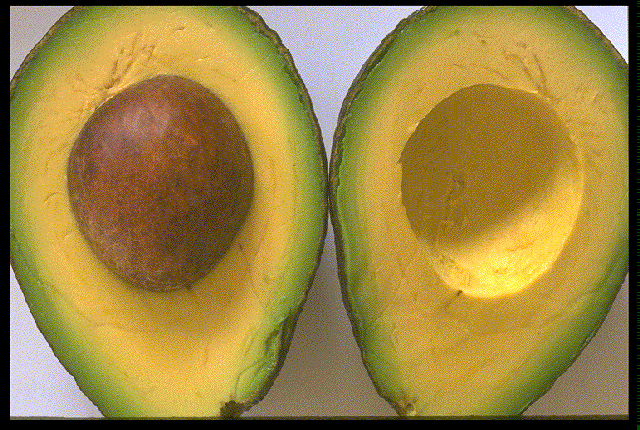
Tracing the history of the avocado, there is archaeological evidence of wild avocados in Tehuacán as early as 7,000BC. No one really knows how wild they were, but one should not underestimate the impulsiveness of a wild avocado, especially before television. I shall only mention that the word 'avocado' comes from the Mexican spanish aguacate, which comes from the Nahuatl word ahuacacuauhitl, and I shall not mention what that means.
Further archaeological signs show that by 500 BC in Tehuacán, and even by 750 BC in Huaca Prieta, Peru, avocados were cultivated. The avocados, with behaviours separated by only blurry lines from their wreckless urges, were also capable of extraordinary finesse and most chivalrous gestures.
Hundreds of years later--- in a different time and place, as often is the case hundreds of years later--- avocados were noticeably absent from the gardens of Spanish missions.

The traditional way of determining the ripeness of an avocado is by checking its squishiness. A successful assessment can be done even with a gentle squish which need not cause irreparable damage to the avocado. This is in contrast to a human-manufactured food, such as pasta, for which the traditional way of checking whether it has been cooked to al dente is by throwing it against the wall. As with Schroedinger's cat, this tends to effectively annihilate the pasta which has been so tested. I have tried it numerous times, and furthermore found this method to be unreliable, despite its extremely high entertainment value.
The global fascination with avocados has certainly passed the test of time, and it has brought inspiration for numerous musical compositions, poems, paintings and sculpure. See the classic text by Bergh, included in a collection edited by Simmonds (1976), simply entitled, "Avocado". Another famous literary text is the story of "The Princess and the Avocado", though later versions replaced the avocado by a pea, and subsequently the princess was replaced by another princess.
Sources for the information presented here include:
Peaches have been described as

A round juicy stone fruit with a fuzzy cream or yellow skin flushed with red. A stone fruit is a single seed enclosed in a protective layer called a pit. The flesh that we eat is the pulp that protects and nurtures the young seed.(see BC Farmscape).
Peaches are indeed fuzzy and sweet; they bruise easily and care must be taken with them. Heavy pruning is needed each year, and those to be eaten fresh are harvested by hand. They grow on trees which are about 3 to 5m tall which only live for 10 to 20 years. They are sensitive and susceptible to insects, disease and insufficient water conditions. Basically, peaches are small yet high-maintenance. Naturally, this suggests the question: "Are they worth it?". They are so sensitive, however, that it might be better just not to ask this question.
Shall I part my hair behind? Do I dare to eat a peach?
I shall wear white flannel trousers, and walk upon the beach.
I have heard the mermaids singing, each to each.
I do not think that they will sing to me.
- T.S. Eliot
Native to China, they were first brought to Europe
about 2000 years ago, and then brought to North America in 1500 by
Spanish explorers.
The storage life of the peach is approximately 3 weeks, if you can call that a life.
Click here to go to the Previous Page
Click here to go to the Next Page